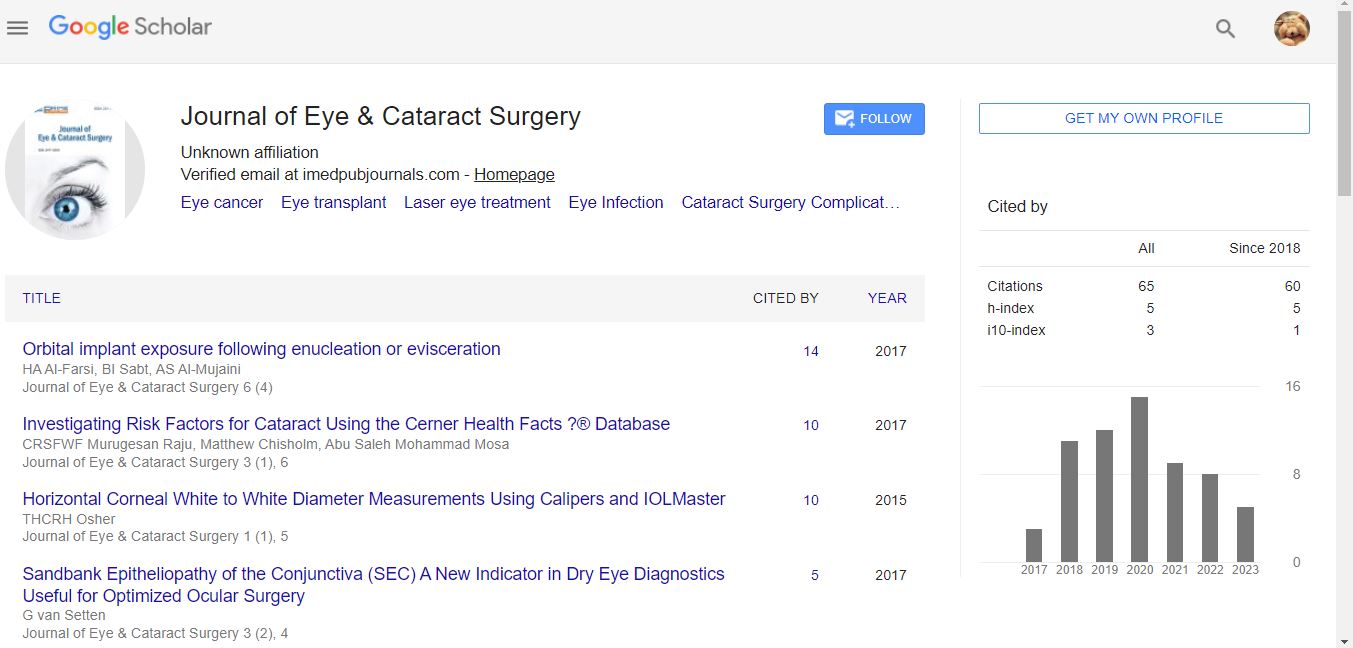Commentary - (2024) Volume 10, Issue 3
Exploring the Benefits and Advancements of Implantable Contact Lenses
Reyes Vincent*
Department of Ophthalmology, University of Advanced Vision Sciences, USA
*Correspondence:
Reyes Vincent,
Department of Ophthalmology, University of Advanced Vision Sciences,
USA,
Email:
Received: 02-Sep-2024, Manuscript No. IPJECS-24-21686;
Editor assigned: 04-Sep-2024, Pre QC No. IPJECS-24-21686 (PQ);
Reviewed: 18-Sep-2024, QC No. IPJECS-24-21686;
Revised: 23-Sep-2024, Manuscript No. IPJECS-24-21686 (R);
Published:
30-Sep-2024, DOI: 10.36648/2471-8300.10.3.26
Description
Implantable contact lenses represent a significant advancement
in the field of vision correction, offering an effective alternative
for individuals with refractive errors who may not be suitable
candidates for traditional laser procedures. These lenses provide
an innovative solution for a range of vision problems, including
myopia, hyperopia, and astigmatism, and are designed to be
permanently placed inside the eye, offering both convenience
and enhanced visual acuity. Understanding the benefits,
indications, and surgical considerations surrounding is essential
for both patients and healthcare professionals. One of the most
compelling advantages of implantable contact lenses is their
ability to deliver excellent visual outcomes, particularly for
patients with high degrees of refractive error. Unlike glasses or
contact lenses that rest on the surface of the eye, are surgically
implanted behind the iris and in front of the natural lens,
allowing for a more natural visual experience. This positioning
minimizes the potential for distortion that can occur with
traditional lenses, resulting in sharper, clearer vision. They
are particularly beneficial for individuals who are not ideal
candidates for laser vision correction due to thin corneas,
high refractive errors, or specific ocular conditions. For these
patients, provide a non-invasive alternative that does not alter
the cornea’s structure, preserving its integrity while effectively
correcting vision. This aspect is especially important for younger
patients or those whose prescriptions may still be changing, as
can be removed or replaced if necessary, providing a degree of
flexibility that other options do not offer. The surgical procedure
for implanting is typically quick and minimally invasive, often
performed on an outpatient basis. Therefore, careful patient
selection and thorough preoperative evaluations are critical
to ensuring optimal outcomes. Eye care professionals must
assess the patient’s overall eye health, refractive error, and
lifestyle to determine if should be informed about the benefits
and risks associated, as well as the importance of adhering to
postoperative care guidelines. Regular follow-up appointments
are essential for monitoring the healing process and ensuring the
long-term success of the implant. Technological advancements
continue to enhance the design and performance of implantable
contact lenses. Innovations such as improved materials,
customizable lens designs, and advanced surgical techniques
have increased the safety and effectiveness of the procedure.
Additionally, the development has made it possible to correct
astigmatism, further broadening the scope of candidates for this
type of vision correction. The popularity is growing, especially
among younger individuals and those with active lifestyles who
seek a more permanent solution to their vision problems. As
more people become aware of the advantages of implantable
contact lenses, the demand for this innovative procedure is
expected to rise. In conclusion, implantable contact lenses offer
a ground-breaking solution for individuals seeking effective
vision correction, particularly those who may not be suitable
candidates for traditional laser procedures. With their ability
to provide excellent visual outcomes, minimal invasiveness,
and flexibility, are becoming an increasingly popular choice in
modern ophthalmology. Ongoing advancements in technology
and surgical techniques will likely continue to enhance the safety
and effectiveness of this procedure, paving the way for improved
vision and quality of life for countless patients worldwide.
Acknowledgement
None.
Conflict Of Interest
None.
Citation: Vincent R (2024) Exploring the Benefits and Advancements of Implantable Contact Lenses. J Eye Cataract Surg. 10:26.
Copyright: © 2024 Vincent R. This is an open-access article distributed under the terms of the Creative Commons Attribution
License, which permits unrestricted use, distribution, and reproduction in any medium, provided the original author and source
are credited.

